
Progress in Biomedical Engineering
Scope & Guideline
Leading the charge in biomedical innovation and collaboration.
Introduction
Aims and Scopes
- Biomedical Device Development:
The journal emphasizes the engineering aspects of biomedical devices, including their design, functionality, and regulatory challenges, which are crucial for translating laboratory innovations into clinical applications. - Tissue Engineering and Regenerative Medicine:
Research articles frequently explore methodologies for creating and improving tissue engineering strategies, including the use of bioprinting and organ-on-chip technologies to develop functional tissue models. - Medical Imaging and Diagnostics:
A core area of focus is the advancement of imaging technologies and diagnostic methods, applying computational techniques and machine learning to enhance image quality and disease detection. - Nanotechnology in Biomedicine:
The journal investigates the application of nanomaterials and nanotechnology in biomedical contexts, including drug delivery, cancer therapy, and the development of novel therapeutic agents. - Wearable and Implantable Technologies:
There is a significant emphasis on wearable devices and bioelectronic implants, exploring their design, functionality, and impact on patient monitoring and rehabilitation. - Artificial Intelligence in Healthcare:
The integration of artificial intelligence and machine learning into healthcare solutions is a prominent theme, with research focusing on its application in diagnostics, patient management, and predictive analytics.
Trending and Emerging
- Organ-on-Chip Technology:
Recent publications highlight a surge in research on organ-on-chip systems, which offer powerful preclinical models for studying various biological processes and drug responses, underscoring their potential for personalized medicine. - 3D Bioprinting and Tissue Models:
The trend towards 3D bioprinting continues to grow, with an emphasis on developing complex tissue models that can mimic physiological environments for research and therapeutic purposes. - Integration of AI and Machine Learning:
The increasing incorporation of artificial intelligence and machine learning in healthcare applications is a key trend, particularly in medical imaging, diagnostics, and patient management, showcasing the potential for improved accuracy and efficiency. - Bioelectronic Medicine and Neural Interfaces:
Research on bioelectronic medicine and neural interfaces is emerging as a significant theme, exploring the interfacing of electronic devices with biological systems for therapeutic applications, particularly in neurology. - Wearable Health Technologies:
There is a marked increase in interest surrounding wearable technologies, particularly in monitoring health metrics and enhancing rehabilitation processes, reflecting the ongoing shift towards personalized and remote healthcare solutions.
Declining or Waning
- Traditional Biomechanics:
Research focused solely on traditional biomechanics without integrating modern technologies or interdisciplinary approaches has seen a decline, as the field increasingly favors innovative methodologies that combine engineering with biological insights. - Basic Biological Mechanisms:
Studies that concentrate solely on basic biological mechanisms without practical applications in engineering or technology development are becoming less frequent, as there is a stronger push for translational research that bridges laboratory findings to clinical applications. - Conventional Surgical Techniques:
There is a noticeable decrease in publications centered on conventional surgical techniques as the focus shifts towards intelligent surgical systems and minimally invasive procedures, driven by technological advancements.
Similar Journals

ANNALS OF BIOMEDICAL ENGINEERING
Elevating biomedical engineering to new heights.ANNALS OF BIOMEDICAL ENGINEERING is a premier journal in the field of biomedical engineering, published by Springer. Established in 1972, this journal has become a vital resource for researchers, professionals, and students engaged in the rapidly evolving domain of biomedical technology. With a commendable impact factor and ranked in the 76th percentile among its peers as per Scopus, it exemplifies excellence in disseminating critical research findings. The journal covers a broad scope of topics related to the integration of engineering principles with medical and biological sciences, facilitating innovations that enhance healthcare outcomes. Although open access is not offered in this journal, it remains an essential platform for scholarly communication, contributing to the continuous advancement of knowledge in biomedical engineering. ANNALS OF BIOMEDICAL ENGINEERING is not only a bridge for academics to share groundbreaking research but also an influential guide for practical applications in medicine and health technologies, making it a fundamental publication for its readership.

MEDICAL ENGINEERING & PHYSICS
Exploring the Intersection of Medicine and EngineeringMEDICAL ENGINEERING & PHYSICS, published by Elsevier Science Ltd, is an esteemed journal in the fields of Biomedical Engineering and Biophysics. With an ISSN of 1350-4533 and an E-ISSN of 1873-4030, it has established itself as a significant resource from its inception in 1994, continuing to deliver pivotal research up to 2024. This journal, categorized in the Q3 quartile for both Biomedical Engineering and Biophysics, holds a respectable position in Scopus rankings, boasting its relevance in the upper echelons of academic inquiry, particularly ranking #75/152 in Biophysics and #158/303 in Biomedical Engineering. Authors and researchers in these dynamic fields will find the journal’s rigorous peer-review process and commitment to publishing high-quality original research invaluable for advancing their work. Although the journal is not open access, it continues to attract submissions that push the boundaries of innovation and application in medical technologies, making it an essential resource for anyone dedicated to the integration of engineering principles with medical sciences.

Advanced NanoBiomed Research
Catalyzing Discoveries in NanobiotechnologyAdvanced NanoBiomed Research is a pioneering open-access journal committed to advancing the interdisciplinary field of nanobiotechnology, published by WILEY-V C H VERLAG GMBH. Since its inception in 2021, this journal has provided a platform for innovative research that bridges the gap between engineering, medicine, and materials science. With impressive rankings in Scopus, positioning it within the top quartiles of various categories, Advanced NanoBiomed Research aims to disseminate high-quality research that contributes to the understanding and application of nanomaterials in biomedical contexts. As it encompasses a wide scope—from applied microbiology to biomaterials—it serves as an essential resource for researchers, professionals, and students eager to explore the cutting-edge developments in the field. The journal promotes a collaborative environment where emerging ideas can flourish, ensuring that vital advancements in nanobiomedicine can be shared and built upon within the scientific community.

Biocybernetics and Biomedical Engineering
Advancing the Frontiers of Biomedical InnovationBiocybernetics and Biomedical Engineering, published by ELSEVIER in the Netherlands, is a prestigious journal that stands at the forefront of the intersecting fields of biomedical engineering and artificial intelligence. With an impressive Impact Factor that places it in the Q1 category for Biomedical Engineering, this journal not only ranks 17th out of 303 in Scopus but also boasts a remarkable percentile ranking of 94th, highlighting its influence and relevance within the scientific community. Since its inception in 2008, Biocybernetics and Biomedical Engineering has aimed to publish cutting-edge research that integrates principles of cybernetics with technological advancements in health care, thereby fostering innovations that improve patient outcomes. Dedicated to advancing knowledge in biomedical technology, the journal serves as a vital resource for researchers, professionals, and students seeking to explore the latest developments and methodologies in the field.

International Journal of Biomedical Engineering and Technology
Advancing Healthcare Through Innovative EngineeringThe International Journal of Biomedical Engineering and Technology, published by INDERSCIENCE ENTERPRISES LTD, serves as a pivotal platform for the dissemination of innovative research in the field of biomedical engineering. This journal, with ISSN 1752-6418 and E-ISSN 1752-6426, has been a valuable resource since its inception in 2007, boasting a converged publication timeline extending to 2024. Based in the United Kingdom, the journal aims to bridge the gap between engineering and biomedical sciences, facilitating interdisciplinary collaboration. As reflected in its 2023 Scopus ranking in the Q4 quartile of Biomedical Engineering, the journal remains accessible for researchers at various stages of their careers, contributing to its significance in promoting advancements in healthcare technologies. While currently not an open-access publication, the journal remains dedicated to enriching the biomedical engineering community by presenting novel research that addresses critical challenges, ultimately aiming to improve patient outcomes and drive innovation in medical devices and therapies.

Biomedical Engineering Letters
Transforming healthcare through cutting-edge research.Biomedical Engineering Letters, published by SpringerNature, is a prominent journal in the field of Biomedical Engineering. With a robust ISSN of 2093-9868 and E-ISSN of 2093-985X, this esteemed journal has established itself as a vital resource for researchers and professionals seeking to advance their knowledge and share groundbreaking findings. Recognized for its quality, Biomedical Engineering Letters holds a distinguished ranking in Scopus, positioned at #94/303 (69th percentile) in the Biomedical Engineering category. The journal covers a diverse scope within biomedical engineering, providing an important platform for innovative research from 2011 to 2024 and facilitating the exchange of ideas among scholars. Although it operates under a subscription model, the journal's commitment to enhancing the field makes it an indispensable reference for those engaged in cutting-edge biomedical research in Germany and globally.

IEEE Open Journal of Engineering in Medicine and Biology
Transforming patient care with cutting-edge research.IEEE Open Journal of Engineering in Medicine and Biology is a premier Open Access journal published by the esteemed IEEE-INST ELECTRICAL ELECTRONICS ENGINEERS INC, dedicated to advancing the interdisciplinary fields of biomedical engineering and medicine. Since its inception in 2020, the journal has quickly established itself within the academic community, boasting a notable ranking of #49 out of 303 in the Biomedical Engineering category on Scopus and achieving an impressive 83rd percentile. With an objective of disseminating high-quality research and innovative developments that bridge engineering and medical sciences, the journal is committed to fostering collaboration among researchers, healthcare professionals, and policymakers. Operating with Open Access since 2020 allows for wider accessibility and dissemination of cutting-edge findings, promoting the exchange of knowledge vital for tackling contemporary challenges in health technology. As the journal continues to grow through to 2024, it remains a vital resource for anyone invested in the enhancement of medical technology and the betterment of patient care.

Journal of Mechanics in Medicine and Biology
Advancing Biomedical Insights through Mechanical PrinciplesThe Journal of Mechanics in Medicine and Biology, published by World Scientific Publishing Co Pte Ltd, serves as a critical platform for interdisciplinary research at the intersection of engineering and biomedical sciences. With an ISSN of 0219-5194 and E-ISSN of 1793-6810, this esteemed journal has been dedicated to exploring the mechanical principles that govern biological systems since its inception in 2008. Based in Singapore, it addresses a diverse range of topics, from biomaterials to biomechanics, contributing valuable insights into the field’s evolving landscape. Although currently positioned in Q4 of Biomedical Engineering according to the 2023 category quartiles, it is poised for growth and increased visibility within the scientific community, fostering innovation and collaboration among researchers, professionals, and students alike. The journal emphasizes the importance of cutting-edge research and its practical implications, making it a vital resource for those striving to enhance the future of medical technologies and biological understanding.

Bioengineering-Basel
Driving Excellence in Bioengineering ResearchBioengineering-Basel, an esteemed journal published by MDPI, stands at the forefront of innovation in the field of bioengineering since its inception in 2014. With an E-ISSN of 2306-5354, this fully Open Access journal based in Switzerland provides a platform for researchers and professionals to disseminate cutting-edge findings across various aspects of bioengineering, including biomaterials, tissue engineering, and biopharmaceuticals. The journal has been recognized with a Q3 ranking in the 2023 Bioengineering category, reflecting its commitment to quality and relevance. By facilitating widespread accessibility to academic knowledge, Bioengineering-Basel aims to foster collaboration and stimulate thought leadership within the global research community, making it an indispensable resource for students, scholars, and industry practitioners alike.

BIOMEDICAL ENGINEERING-APPLICATIONS BASIS COMMUNICATIONS
Exploring the future of biomedical applications.BIOMEDICAL ENGINEERING-APPLICATIONS BASIS COMMUNICATIONS is a prominent journal dedicated to the dynamic field of biomedical engineering, published by WORLD SCIENTIFIC PUBL CO PTE LTD. Since its inception in 1992, the journal has provided a platform for the dissemination of high-quality research and innovative applications within the biomedical engineering domain. Despite its current Q4 ranking in multiple categories such as Bioengineering and Biomedical Engineering, the journal serves as an essential resource for researchers and professionals seeking to explore the latest developments and practical applications in this interdisciplinary field. The journal is based in Singapore, reflecting the region's growing influence in scientific research and technology. Although it does not offer open access, it continues to attract submissions that enrich the scientific dialogue within its community. With a commitment to fostering knowledge and research collaboration, this journal remains a vital contributor to the ongoing advancements in biomedical technology and engineering.